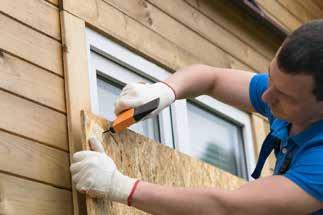
4 minute read
Career
How to Eat to Feel Strong While Sheltering in Place W ith social distancing orders in place in many areas across the country, you may be doing your grocery shopping with shelf stability in mind. But this factor should not be your only priority. Right now, it’s especially important that the foods you eat also support your health and longevity.
Here are three things to know about eating to feel strong while sheltering in place: 1. Empty Calories Should Get the Boot. Many products designed to last a long time don’t contain the vital nutrients your body needs, and instead, contain artificial ingredients that lead to quick energy and crash cycles. While empty calories will keep you alive, they won’t allow you to thrive, promoting fat over muscle and actually weakening your body’s ability to defend itself. 2. Nutrients Ignite Your Body’s Natural Power to Defend. The COVID-19 crisis highlights the fact that those with compromised immune systems and those with chronic disease are often the most vulnerable to viral infection. Fortunately, you can help to boost your immunity and defend against certain chronic diseases with a nutrient-packed diet. Why? Nutrients nourish your cells, defend against free radicals, give you energy, and aid muscle growth and repair. 3. Eating to Thrive is Easier Than it Sounds. Getting the “Big Five” -- protein, vitamins, minerals, omega-3s and fiber -- doesn’t have to be a challenge during difficult situations. To get all your essential nutrients in every meal, consider stocking up on products supported by research, such as Nutrient Survival, a line of nutrient dense foods and drinks that are simple to make. Developed by a team of food scientists, researchers, chefs, outdoorsmen, survivalists and adventure athletes who were frustrated with the lack of effective emergency food options, these non-perishable snacks, drinks, entrées and even coffee are high in protein and contain 14 vitamins and 14 minerals, so you can provide your body with what it needs throughout the day. To learn more, visit NutrientSurvival.com.
Advertisement
Social disruption should not stop your ability to survive and thrive. In these challenging times, fueling your body right is one of the most important steps you can take to protect yourself. (Statepoint) PHOTO SOURCE: (c) Yuliya Apanasenka / iStock via Getty Images Plus Fuel your body right and give empty calories the boot.
How Families and Communities Can Prepare for Natural Disasters
(Statepoint)
Natural disasters are increasing in severity and frequency. However, studies show that advance planning can keep individuals healthier and safer and support faster recovery for communities.
Building Safety Month, an international campaign to raise awareness about building safety celebrated every May, is a great reminder that one of the most effective ways to prepare is by enforcing up-to-date building codes.
Studies show that adopting the International Residential and Building Codes generates a national benefit of $11 for every $1 invested, while proper code enforcement decreases losses following disasters by up to 25 percent. When states and local jurisdictions apply the latest codes and they’re diligently enforced, they’re also more likely to qualify for federal pre-disaster mitigation funding and additional post-disaster recovery assistance.
However, only 31 percent of hazard-prone jurisdictions in the U.S. have adopted the latest two editions of hazard-resistant building codes. Fortunately, newly expanded Federal Emergency Management Agency and U.S. Department of Housing and Urban Development grants will fund code adoption, administration and enforcement pre- and post-disaster, providing new resources for American communities.
Contact your elected officials, building department, or permitting office to learn how you can support adoption and enforcement of modern building codes and standards in your community. Additionally, you can help protect your family with these disaster safety
and mitigation tips from the International Code Council, a nonprofit association that provides a wide range of solutions in support of safe, sustainable, affordable and resilient structures, especially as hurricane season is fast approaching: • Install tested and code-approved shutters for protection from windborne debris if you live in a high wind or hurricane prone area. If this isn’t possible, consider temporarily protecting doors and windows by mounting exterior grade, 7/16-inch minimum thickness plywood and fastening it into place. • Consider building or retrofitting a storm safe room in your home. During the planning stages with the contractor, be sure to confirm they are building to the most recent codes and standards, such as the ICC/NSSA 500 Standard for the Design and Construction of Storm Shelters, to pro
PHOTO SOURCE: (c) Kurgu128 / iStock via Getty Images Plus

vide the highest level of protection for your family. • In flood-prone areas, consider raising your home up to 10 feet above the base flood elevation. According to the National Institute of Building Sciences, an elevation retrofit yields a benefit of $6 for every $1 spent. • In wildfire-prone areas, remove dead grass, leaves, twigs and branches within 30 feet of a building. Be sure to remove dry leaf and pine litter from roofs, rain gutters, decks and walkways. See the Code Council’s International Wildland-Urban Interface Code for detailed requirements. • When designing, remodeling or constructing a home, keep dangers posed by natural disasters local to your region top-of-mind. For instance, those in hurricane or flooding-prone areas can construct break-away walls and flood openings to prevent pressure buildup. Those in wildfire-prone areas should be sure to use fire-resistant materials for landscaping and construction. • Purchase property insurance customized to cover threats specific to your region, including flooding. Just one inch of water can cause $25,000 of damage to your home and standard homeowners and renters insurance policies don’t typically cover flood damage.
More tips as well as information about the Code Council’s work to assist devastated communities with post-disaster building plan reviews, inspections and permit operations can be found at BuildingSafetyMonth.org.
While natural disasters are beyond our control, building to modern codes can mitigate their impact, supporting safer, more resilient communities.









